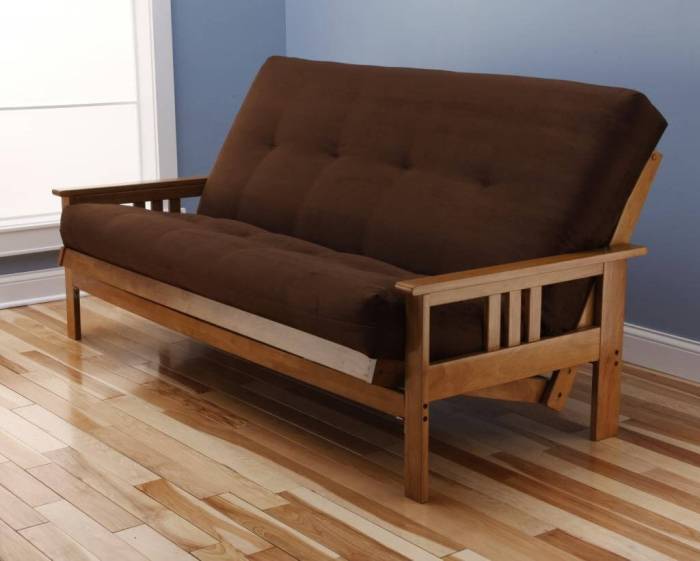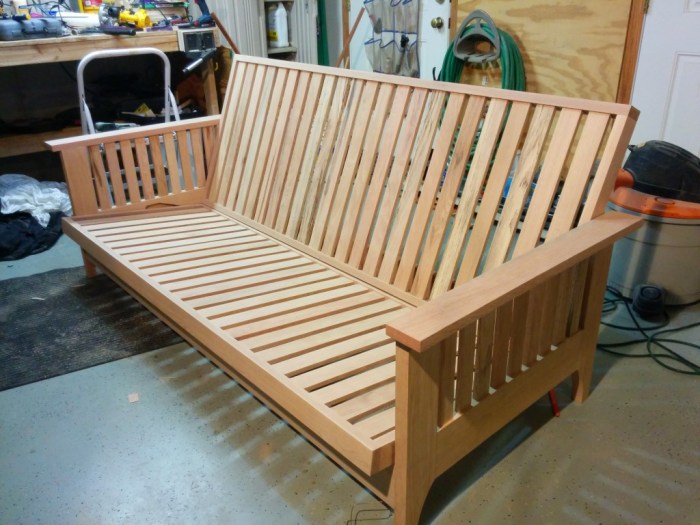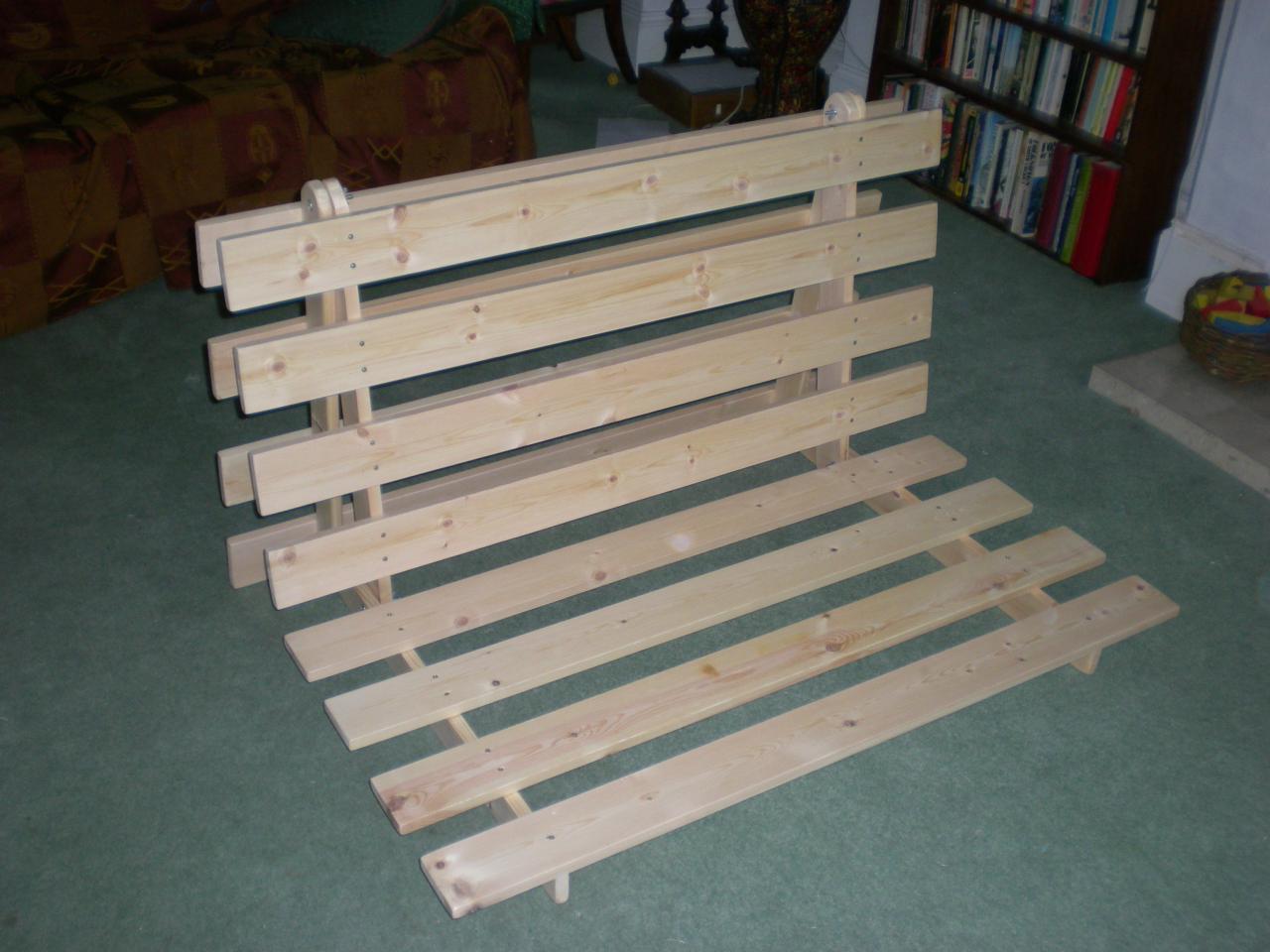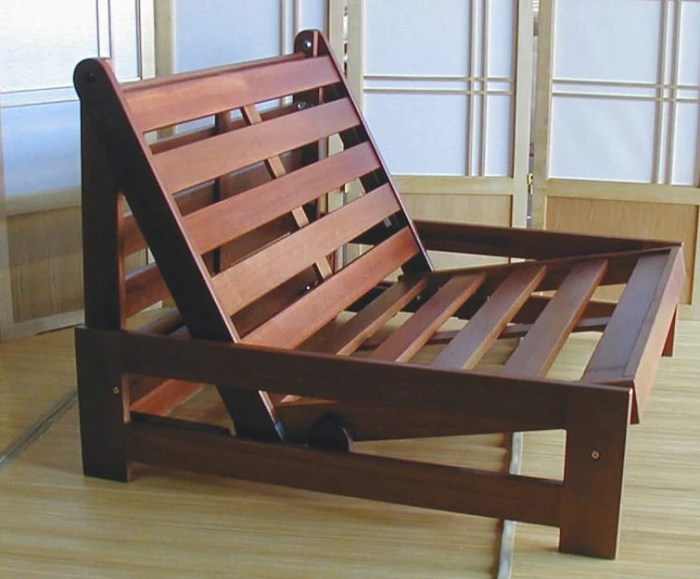Futon woodworking plans offer a chance to craft a unique and comfortable piece of furniture for your home. Whether you’re a seasoned woodworker or a beginner, building your own futon frame provides a rewarding and personalized experience. From selecting the right wood to mastering joinery techniques, this guide will walk you through the process of creating a durable and stylish futon that perfectly suits your needs.
The first step is choosing the right wood for your futon frame. Hardwoods like oak, maple, and cherry offer strength and durability, while softer woods like pine and cedar provide a more rustic aesthetic. Consider the style and functionality you desire, as well as the level of woodworking expertise you possess, when making your selection.
Futon Frame Construction

Building a sturdy and comfortable futon frame requires careful consideration of materials and construction techniques. The frame acts as the foundation for your futon, supporting both its weight and your comfort. Let’s delve into the key aspects of futon frame construction.
Wood Selection for Futon Frames
The type of wood you choose for your futon frame will significantly impact its durability, appearance, and cost. Here are some common wood choices and their pros and cons:
- Hardwoods (Oak, Maple, Cherry): Known for their strength, durability, and beautiful grain patterns. They are more expensive but offer excellent longevity and a classic look.
- Softwoods (Pine, Fir): These woods are more affordable and easier to work with. However, they are less durable and may be prone to scratches or dents.
- Engineered Woods (Plywood, MDF): These are cost-effective options, offering consistent strength and stability. They are less prone to warping or cracking than solid wood but may not have the same aesthetic appeal.
Constructing a Sturdy Futon Frame
A well-constructed futon frame is essential for both its functionality and longevity. Here’s a step-by-step guide to building a sturdy frame:
- Design and Planning: Begin by sketching out your desired frame dimensions and style. Consider the size of your futon mattress, the desired seating height, and any additional features like armrests or storage compartments.
- Cutting Wood: Once you have your design, cut the wood pieces to the required dimensions. Use a saw with a sharp blade for precise cuts.
- Joint Selection: Choose strong and durable joints for your frame, such as mortise and tenon, dovetail, or pocket-hole joints. These joints ensure the frame’s stability and prevent it from coming apart.
- Wood Preparation: Sand all the wood surfaces smoothly to prevent splinters and ensure a clean finish. Apply a wood finish, such as paint or stain, if desired.
- Assembly: Carefully assemble the frame using your chosen joints. Secure the joints with glue and screws or dowels for added strength.
- Finishing Touches: Once the frame is assembled, apply any additional finishing touches, such as upholstery or hardware, to complete the design.
Tools and Equipment for Futon Frame Construction
Having the right tools and equipment will make your futon frame construction process smoother and more efficient. Here’s a list of essential tools:
- Measuring Tape: For accurate measurements and cutting.
- Saw: A circular saw, miter saw, or table saw for cutting wood to size.
- Drill: For drilling pilot holes and securing joints with screws.
- Screwdriver: For driving screws into the frame.
- Clamps: To hold the frame pieces together during assembly.
- Wood Glue: To bond the joints and add strength to the frame.
- Sandpaper: For smoothing the wood surfaces and creating a clean finish.
- Safety Gear: Always wear safety glasses, gloves, and hearing protection while working with power tools.
Design Tips for Futon Frame Comfort and Functionality
Consider these design tips to maximize comfort and functionality in your futon frame:
- Mattress Thickness: Select a mattress thickness that complements the frame’s design. A thicker mattress may require a higher frame to achieve a comfortable seating height.
- Seating Height: Choose a frame height that provides a comfortable seating position. A standard seating height for a futon is around 18 inches.
- Backrest Angle: The backrest angle should be comfortable for both sitting and sleeping. Consider a slight recline for optimal comfort.
- Armrests: Adding armrests can enhance comfort and support. Ensure they are positioned at a comfortable height and width.
- Storage Space: Consider incorporating storage compartments beneath the futon seat for blankets, pillows, or other items.
Futon Mattress Options

Choosing the right futon mattress is crucial for ensuring comfort, durability, and overall satisfaction with your futon. Different types of futon mattresses cater to various preferences and needs, offering a range of comfort levels, durability, and price points.
Traditional Cotton Futon Mattresses
Traditional cotton futon mattresses are known for their natural breathability, comfort, and affordability. They typically consist of layers of cotton batting, often with a cotton cover.
- Pros:
- Natural and breathable, allowing for good airflow and temperature regulation.
- Provides a soft and comfortable sleeping surface, conforming to the body’s contours.
- Generally more affordable than other types of futon mattresses.
- Cons:
- May require regular fluffing and adjusting to maintain shape and comfort.
- Can be prone to sagging over time, especially with heavier use.
- Not as durable as foam or hybrid futon mattresses.
Foam Futon Mattresses
Foam futon mattresses offer a more supportive and durable option compared to traditional cotton mattresses. They are typically made from polyurethane foam, which comes in various densities and firmness levels.
- Pros:
- Provides excellent support and pressure relief, reducing aches and pains.
- More durable than cotton mattresses, resisting sagging and maintaining shape over time.
- Available in various firmness levels to suit different sleeping preferences.
- Cons:
- Can trap heat, leading to discomfort for some sleepers.
- May not be as breathable as cotton mattresses.
- Can be more expensive than traditional cotton futon mattresses.
Hybrid Futon Mattresses
Hybrid futon mattresses combine the benefits of both traditional cotton and foam mattresses. They typically feature a layer of foam for support and a layer of cotton for comfort and breathability.
- Pros:
- Offers a balance of comfort, support, and durability.
- Provides good airflow and temperature regulation.
- Available in a range of firmness levels and designs.
- Cons:
- Can be more expensive than traditional cotton or foam futon mattresses.
- May require more maintenance than foam mattresses.
Choosing the Right Futon Mattress
Selecting the right futon mattress depends on individual needs and preferences, considering factors like sleeping position, weight, and desired firmness.
- Sleeping Position:
- Side Sleepers: Look for a mattress with medium to firm support to align the spine and prevent pressure points.
- Back Sleepers: A medium-firm mattress is generally recommended to maintain spinal alignment and provide adequate support.
- Stomach Sleepers: A firmer mattress is typically preferred to prevent excessive sinking and strain on the back.
- Weight:
- Heavier individuals may benefit from a firmer mattress to provide adequate support and prevent sagging.
- Lighter individuals may prefer a softer mattress for greater comfort and pressure relief.
- Desired Firmness:
- Soft: Provides a plush and sinking feel, ideal for those who prefer a more cushioned sleeping experience.
- Medium: Offers a balance of comfort and support, suitable for most sleepers.
- Firm: Provides a more rigid and supportive feel, ideal for those who prefer a firmer sleeping surface.
Futon Mattress Care and Maintenance
Proper care and maintenance are essential for extending the lifespan of your futon mattress.
- Regular Fluffing and Rotating:
- Fluff and rotate your futon mattress regularly to distribute the filling evenly and prevent sagging.
- For cotton futon mattresses, fluffing helps restore the loft and comfort.
- Spot Cleaning and Airing:
- Spot clean any spills or stains promptly to prevent them from setting in.
- Air out your futon mattress regularly to remove moisture and prevent odor build-up.
- Using a Mattress Protector:
- A mattress protector helps shield your futon mattress from spills, stains, and wear and tear.
- Choose a breathable and waterproof protector to ensure optimal comfort and protection.
Futon Woodworking Plans and Resources

Building a futon frame is a rewarding woodworking project that allows you to create a custom piece for your home. With the right plans and resources, you can construct a sturdy and stylish futon frame that perfectly complements your décor.
Types of Futon Woodworking Plans
There are various types of futon woodworking plans available, catering to different skill levels and preferences. Understanding the different types can help you choose the right plan for your project.
- Beginner-friendly plans offer simple designs and detailed instructions, making them ideal for novice woodworkers. These plans typically use basic joinery techniques and straightforward cuts, providing a gentle introduction to woodworking.
- Advanced plans challenge experienced woodworkers with complex designs, intricate joinery, and demanding cuts. These plans may incorporate unique features, such as curved surfaces or intricate carvings, requiring a higher level of skill and precision.
- Customizable plans offer flexibility, allowing you to modify the design to suit your needs and preferences. These plans provide a framework for your project, enabling you to adjust dimensions, materials, and features to create a personalized futon frame.
Essential Elements of Quality Futon Woodworking Plans
A good futon woodworking plan is more than just a set of diagrams; it’s a comprehensive guide that ensures a successful project.
- Detailed instructions are crucial for understanding each step of the construction process. They should be clear, concise, and easy to follow, providing step-by-step guidance for cutting, assembling, and finishing the futon frame.
- Clear diagrams are essential for visualizing the design and understanding the assembly process. They should accurately represent the dimensions, joinery, and overall layout of the futon frame, making it easier to follow the instructions and avoid mistakes.
- Material lists are essential for gathering the necessary materials. They should specify the types, quantities, and sizes of wood, hardware, and finishing materials needed for the project. This helps ensure you have everything on hand before starting and avoids delays or unexpected costs.
Interpreting and Utilizing Futon Woodworking Plans
Once you have chosen a plan, it’s important to understand how to interpret and utilize it effectively.
- Read the plan thoroughly before starting the project. This allows you to familiarize yourself with the design, materials, and construction process, ensuring you have a clear understanding of what’s involved.
- Study the diagrams carefully to visualize the assembly process. Pay attention to the dimensions, joinery, and overall layout, making sure you understand how the different parts fit together.
- Gather all necessary materials before starting construction. This ensures you have everything on hand and avoids interruptions or delays during the project.
- Follow the instructions carefully, taking your time and double-checking measurements. This helps ensure accuracy and avoids mistakes that can lead to rework or frustration.
- Prioritize safety by using appropriate tools and safety gear. Always wear eye protection, dust masks, and hearing protection when working with power tools and woodworking machinery.
Futon Design and Style: Futon Woodworking Plans

Your futon frame is more than just a place to sleep; it’s a design element that can significantly impact the overall aesthetic of your room. From traditional to modern, there’s a futon style to complement every taste and décor.
Traditional Futon Designs
Traditional futon designs often feature a simple, minimalist aesthetic, often constructed from natural wood like cherry or oak. These frames typically have a rectangular shape with clean lines and a low profile, emphasizing functionality and practicality. They often incorporate natural fabrics like cotton or linen for upholstery, contributing to a rustic and cozy ambiance.
Modern Futon Designs, Futon woodworking plans
Modern futon designs embrace clean lines, geometric shapes, and a focus on functionality. They often feature sleek metal frames, minimalist upholstery, and bold colors, creating a contemporary and sophisticated look. Modern futons can be found in a range of materials, including metal, wood, and even leather.
Contemporary Futon Designs
Contemporary futon designs blend modern elements with a touch of eclecticism. They often feature unique materials like reclaimed wood, exposed metal frames, or bold patterns in the upholstery. Contemporary futons embrace a mix of styles and textures, creating a unique and personalized look.
Futon Designs with Unique Features
Beyond the basic frame, futon designs can incorporate unique features that enhance both functionality and style.
Storage Compartments
Futons with built-in storage compartments provide a practical solution for maximizing space. These compartments can be incorporated into the base of the futon frame, offering hidden storage for bedding, blankets, or other items.
Built-in Shelves
Futons with built-in shelves offer additional storage space for books, decorative items, or electronics. These shelves can be incorporated into the headboard or side panels, adding functionality and visual interest to the design.
Headboards
Headboards can significantly enhance the style and comfort of a futon. They can be designed in a variety of styles, from simple and minimalist to elaborate and ornate. Headboards can also be upholstered in a variety of fabrics and colors, adding a personal touch to the design.
The Role of Wood Finishes and Upholstery
The choice of wood finishes and upholstery plays a crucial role in shaping the overall look and feel of a futon.
Wood Finishes
Wood finishes can add depth, warmth, and character to a futon frame. Natural finishes like clear oil or stain allow the wood’s grain to shine through, creating a rustic and timeless aesthetic. Darker finishes like walnut or ebony add a touch of sophistication and drama.
Upholstery
Upholstery plays a significant role in determining the comfort and style of a futon. Natural fabrics like cotton and linen are durable, breathable, and offer a classic look. Leather upholstery adds a touch of luxury and durability. Synthetic fabrics like microfiber are often chosen for their affordability and ease of maintenance.
Futon Building Techniques
Building a futon frame requires precision and skill. It’s a great way to create a unique piece of furniture that suits your needs and style. This section will guide you through the process of cutting, shaping, and joining wood to build a sturdy and attractive futon frame.
Cutting and Shaping Wood
Cutting and shaping wood are essential steps in futon frame construction. They require precision and safety.
- Cutting: Start by cutting the wood to the desired lengths using a saw. A circular saw is efficient for straight cuts, while a jigsaw is ideal for curved or intricate shapes. Measure carefully before cutting, and always wear safety goggles and ear protection.
- Shaping: Shaping wood involves creating specific profiles or contours. Routers are powerful tools for shaping edges, creating grooves, or adding decorative details. Use a router table for safer and more precise shaping. Always use the correct router bit and work slowly and carefully.
Joining Wood
Joining wood pieces is crucial for creating a sturdy and durable futon frame. Different techniques are used for various joints, each offering unique advantages.
- Mitering: Mitering involves cutting two pieces of wood at 45-degree angles to create a clean, mitered joint. It’s often used for corner joints, providing a visually appealing and strong connection. Use a miter saw for accurate mitering.
- Dadoing: Dadoing involves cutting a rectangular groove in one piece of wood to accommodate the thickness of another piece. It’s a strong and durable joint, commonly used for shelf construction. Use a dado set on a table saw for accurate dado cuts.
- Rabbetting: Rabbetting involves creating a rectangular recess along the edge of a piece of wood. It’s used for joining two pieces at a 90-degree angle, creating a strong and flush surface. Use a router or a table saw with a rabbeting jig for precise rabbet cuts.
Assembling the Futon Frame
Assembling the futon frame requires attention to detail and proper alignment to ensure stability and longevity.
- Alignment: Ensure that all pieces are aligned correctly before joining them. Use clamps to hold the pieces together during assembly.
- Joint Strength: Use wood glue and screws or dowels to secure the joints. Ensure the glue is evenly spread and the screws are driven straight and deep.
- Finishing: After assembly, sand the frame to remove any rough edges and imperfections. Apply a wood finish, such as stain or paint, to protect the wood and enhance its appearance.
Troubleshooting Common Woodworking Challenges
Woodworking can present challenges. Knowing how to address them is crucial for successful project completion.
- Wood Splintering: To prevent wood from splintering, use a sharp blade when cutting and make sure the wood is properly supported.
- Glue Stains: To avoid glue stains, use a glue spreader to apply a thin layer of glue and wipe away any excess glue immediately.
- Uneven Finish: To achieve an even finish, sand the wood with different grit sandpaper, starting with coarse grit and progressing to fine grit.
Conclusive Thoughts

Building your own futon is a journey of creativity and craftsmanship. By following these plans, you can transform simple materials into a functional and stylish piece of furniture that will be a source of comfort and pride for years to come. Remember to enjoy the process, experiment with different design elements, and don’t be afraid to personalize your creation to reflect your unique style.
FAQ Overview
What are the best tools for futon frame construction?
Essential tools include a saw, drill, sander, router, measuring tape, and clamps. The specific tools you’ll need will depend on the complexity of your design and the types of joints you choose to use.
How do I choose the right futon mattress for my frame?
Consider your sleeping preferences, weight, and desired firmness. Traditional cotton futon mattresses offer a firm and supportive sleep, while foam and hybrid options provide more cushioning and contouring.
What are some tips for achieving a professional-looking finish?
Sand your wood thoroughly to create a smooth surface. Apply a stain or paint to enhance the wood’s natural beauty or create a custom look. Finally, seal the wood with a protective finish to prevent scratches and water damage.
Building a futon frame is a great project for woodworkers of all levels, but if you’re just starting out, you might want to check out some beginners woodworking plans to get a feel for the basics. Once you’ve mastered those, you’ll be ready to tackle a futon frame with confidence!
